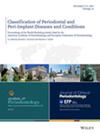Clinical and histological outcomes of allogenic amnion–chorion membrane for palatal donor site healing
IF 4.2
2区 医学
Q1 DENTISTRY, ORAL SURGERY & MEDICINE
引用次数: 0
Abstract
BackgroundThis pilot split‐mouth randomized controlled trial aimed to compare the effectiveness of an allogenic amnion–chorion membrane (ACM) in promoting clinical and histological palatal donor site wound healing to a collagen dressing (CLD).MethodsTwo palatal donor sites (right and left) of 19 participants requiring free gingival graft (FGG) procedures were randomly assigned to receive either ACM (test group) or CLD (control group). Clinical outcomes, including the size of the wound area, the degree of epithelialization, color match, bleeding condition, pain, and sensibility, were measured. Histomorphometric analyses were also performed to compare the effectiveness of the dressing in each group. Outcomes were evaluated 4, 10, 14, 21, 28, 45, and 60 days post‐operatively.ResultsThere were no significant differences in the reduction of wound area size, the degree of epithelialization, color change, pain, sensibility, thickness of the epithelium and keratin layer, number of inflammatory cells, fibroblasts and blood vessels, and density of collagen between ACM and CLD palatal donor sites during all the evaluations.ConclusionsThe effectiveness of ACM in supporting wound healing at the palatal FGG donor site was comparable to that of CLD.Clinical Trial RegistrationThis study was registered with ClinicalTrials.gov (ID NCT03713073). The title of the trial is Clinical and Histological Outcomes of Allogenic Amnion Chorion Membrane in the Healing of Free Gingival Graft Donor Site.Plain language summaryThis study looked at how well 2 different treatments help wounds heal after a free gingival graft procedure, which requires taking donor tissue from the palate. Nineteen participants had 2 areas on their palates treated: 1 with an allogenic amnion–chorion membrane (ACM) and the other with a collagen dressing. The study compared the healing process by looking at the size of the wound, the kinetics of the wound healed, the pain experienced, and the tissue's appearance. It also examined the treated sites under a microscope to assess the number of cells involved in the healing process. After evaluating the healing progress at several time points (from 4 to 60 days after surgery), no significant differences between the 2 treatments were found in terms of clinical or microscopic healing outcomes. In conclusion, ACM was found to be as effective as the collagen dressing in promoting healing at the donor site, meaning both treatments can be considered equally viable options for this procedure.同种异体羊膜-绒毛膜用于腭供区愈合的临床和组织学结果
本试验旨在比较异体羊膜-绒毛膜(ACM)与胶原敷料(CLD)在促进腭供区临床和组织学伤口愈合方面的有效性。方法选取19例需要游离龈移植(FGG)的患者,随机分为左、右两个腭供区,分别接受ACM组(试验组)和CLD组(对照组)。测量临床结果,包括伤口面积大小、上皮化程度、颜色匹配、出血情况、疼痛和敏感性。还进行组织形态学分析以比较各组敷料的有效性。评估术后4、10、14、21、28、45和60天的结果。结果两组在创面面积缩小、上皮化程度、颜色变化、疼痛、敏感性、上皮和角蛋白层厚度、炎症细胞、成纤维细胞和血管数量、胶原密度等方面均无显著差异。结论ACM支持腭FGG供区创面愈合的效果与CLD相当。临床试验注册本研究已在ClinicalTrials.gov注册(编号NCT03713073)。该试验的标题是同种异体羊膜在游离牙龈移植供体愈合中的临床和组织学结果。这项研究观察了两种不同的治疗方法如何帮助游离牙龈移植手术后的伤口愈合,这需要从上颚取下供体组织。19名参与者在他们的腭上有两个区域进行了治疗:一个区域使用同种异体羊膜-绒毛膜(ACM),另一个区域使用胶原蛋白敷料。该研究通过观察伤口的大小、伤口愈合的动力学、经历的疼痛和组织的外观来比较愈合过程。它还在显微镜下检查了治疗部位,以评估参与愈合过程的细胞数量。在多个时间点(术后4 ~ 60天)评估愈合进展后,两种治疗方法在临床或显微镜下的愈合结果均无显著差异。总之,ACM在促进供体部位愈合方面与胶原蛋白敷料一样有效,这意味着这两种治疗方法可以被认为是同样可行的选择。
本文章由计算机程序翻译,如有差异,请以英文原文为准。
求助全文
约1分钟内获得全文
求助全文
来源期刊

Journal of periodontology
医学-牙科与口腔外科
CiteScore
9.10
自引率
7.00%
发文量
290
审稿时长
3-8 weeks
期刊介绍:
The Journal of Periodontology publishes articles relevant to the science and practice of periodontics and related areas.
 求助内容:
求助内容: 应助结果提醒方式:
应助结果提醒方式:


